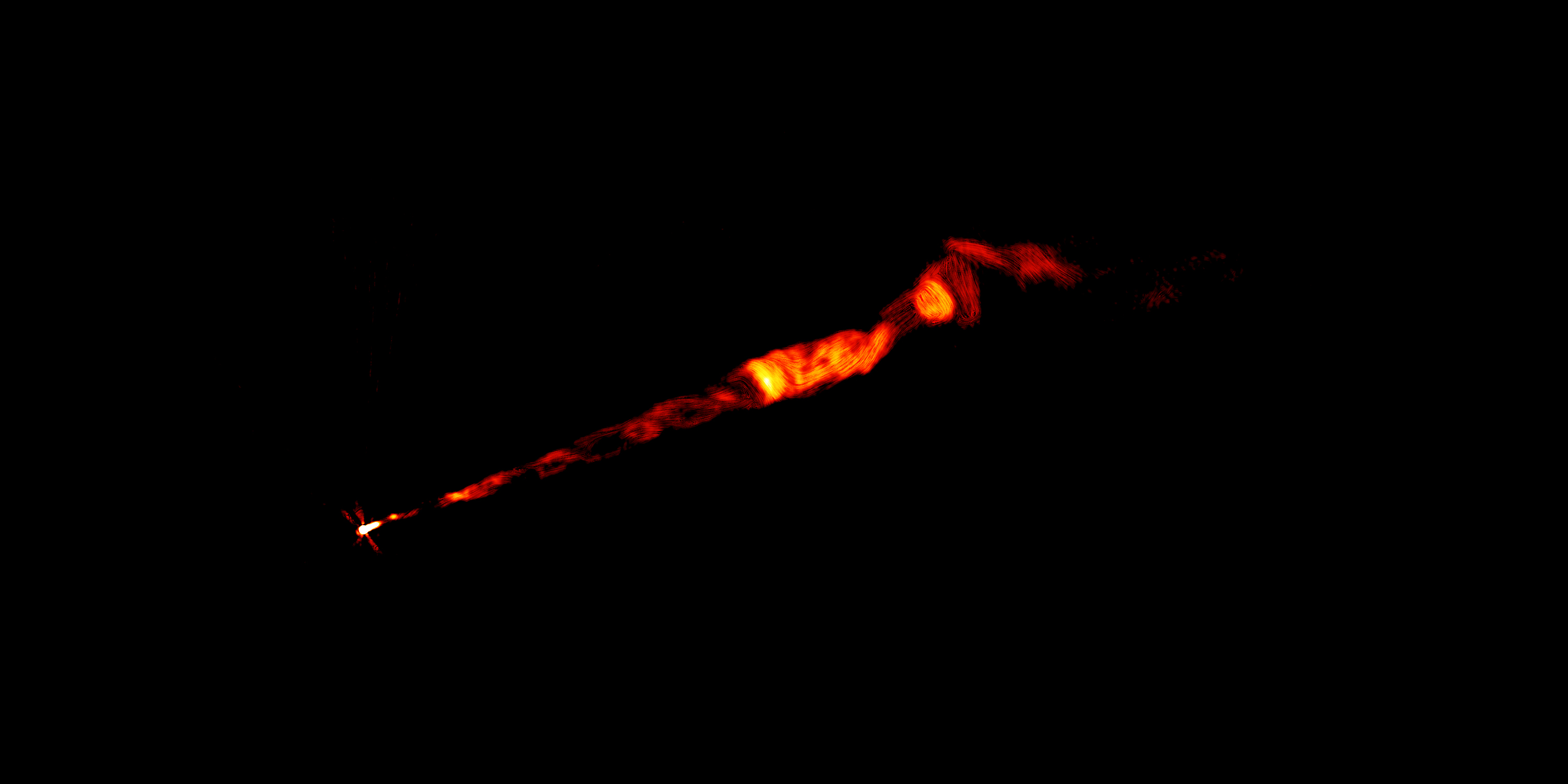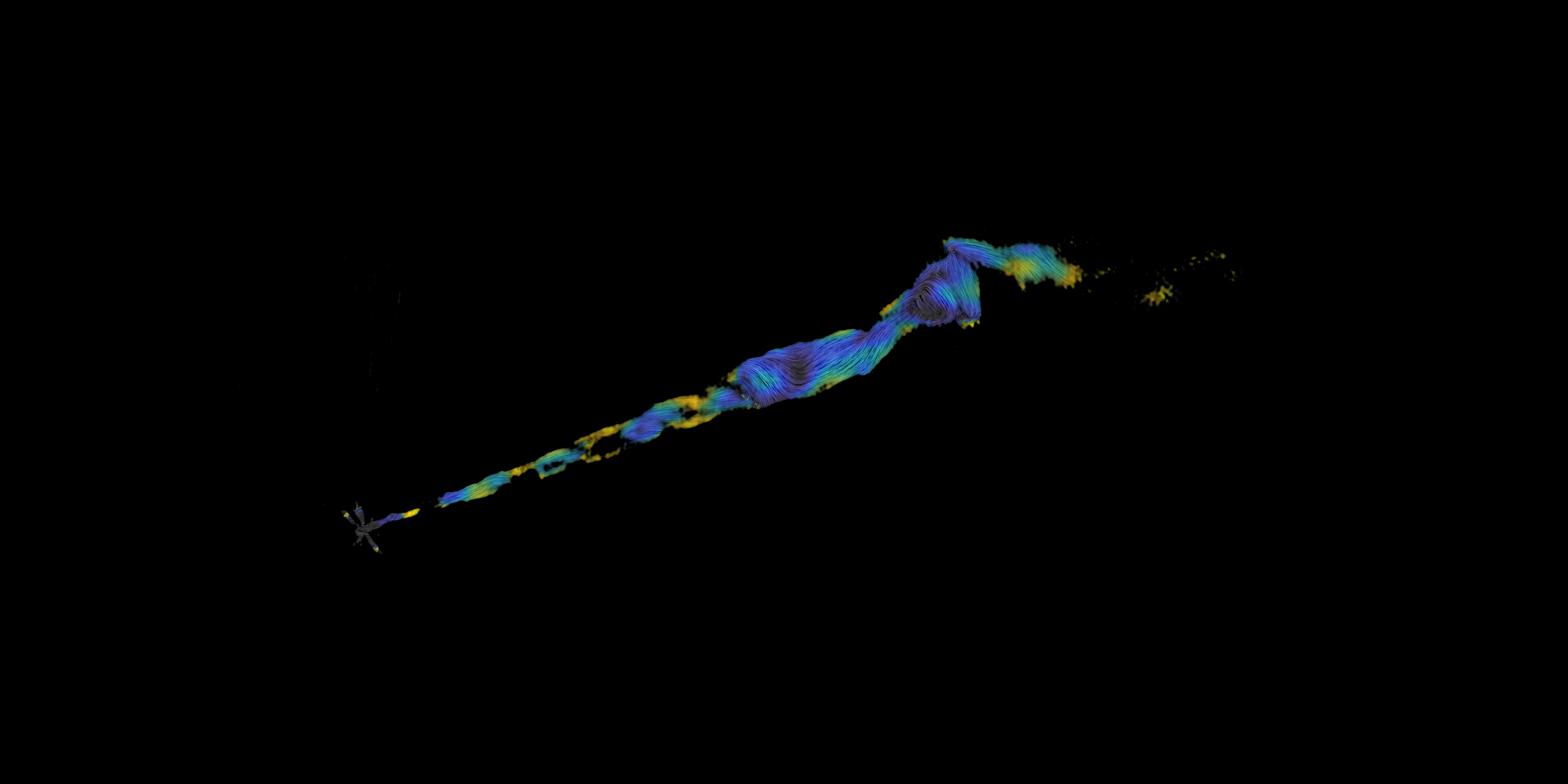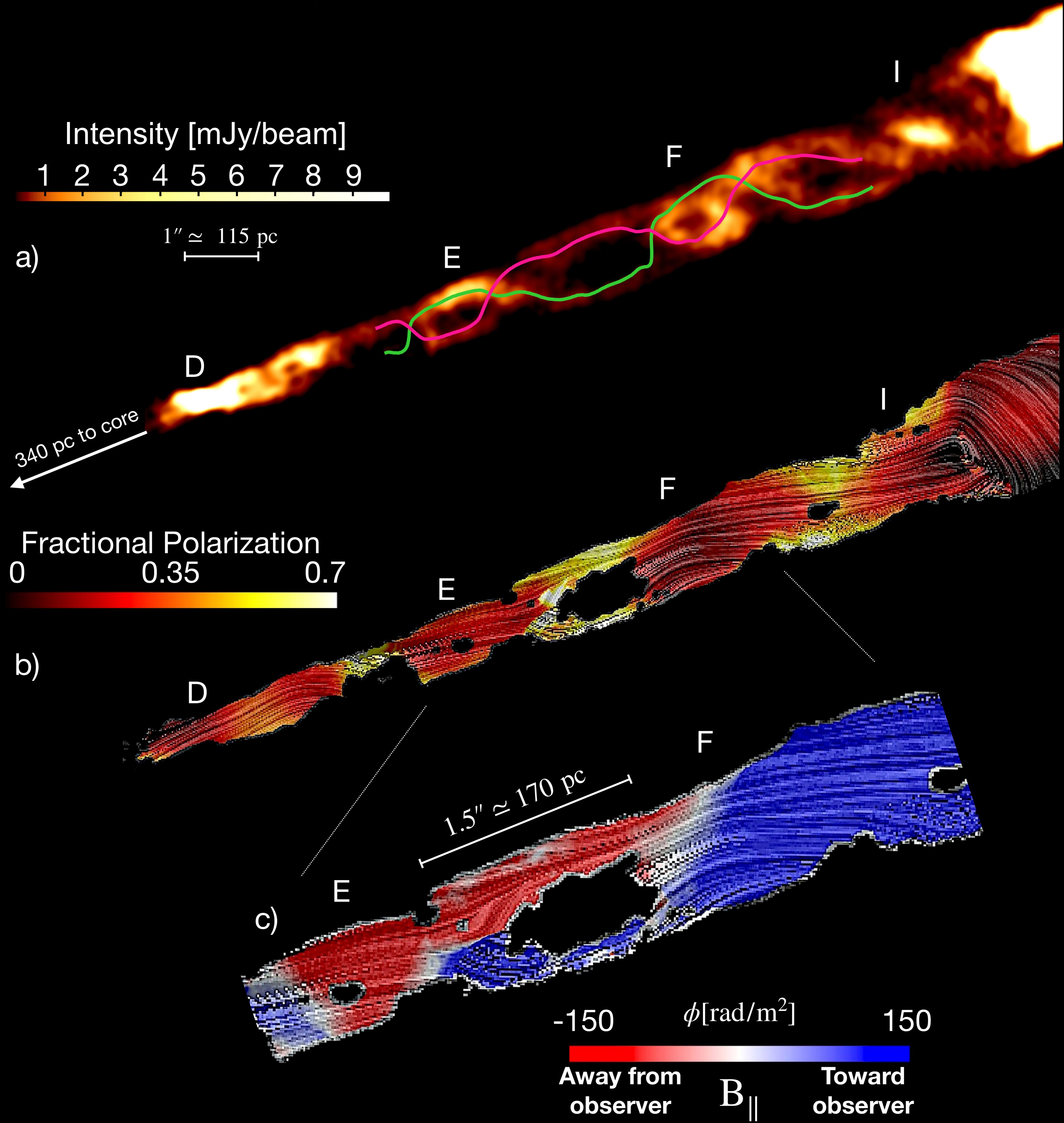An international team of astronomers studied the gas jet expelled from the center of a giant galaxy and found a magnetic field in the form of a corkscrew that funnels and shapes the jet material to a distance of nearly 3,300 light-years. This is the furthest distance from the jet origin that a magnetic field has yet been detected.
“For the first time we were able to reveal the 3-dimensional structure of the magnetic field that shapes the jet in Messier 87 (M 87)”, said Dr. Alice Pasetto, from the Institute of Radio Astronomy and Astrophysics (IRyA) at UNAM, Mexico, who led this study. “The material in this jet traces a double helix, similar to the structure of DNA”, she added.
M 87 is a giant elliptical galaxy about 55 million light-years away from our Solar System. It hosts a supermassive black hole of approximately 6.5 million solar masses at its center. The image of this black hole was the first obtained of such an object, published by the Event Horizon Telescope (EHT) collaboration in 2019.
Dr. Pasetto and her team measured the intensity and polarization (i.e., alignment) of the magnetic field in different parts of the jet in M 87. “To do this, we observed the jet in a wide range of radio frequencies using the Karl G. Jansky Very Large Array (VLA) in New Mexico, USA. The resolution (i.e., the level of detail) of our observations allowed us to distinguish the width of the structures in the material in the jet”, said Dr. Pasetto.
In March 2021, the EHT collaboration published a new image showing the magnetic fields in the region very close to the central black hole in M 87. “Helical magnetic fields are expected close to the black hole, and are thought to play a highly important role in channeling the material into a narrow jet”, said Dr. Carlos Carrasco-González, also from IRyA, who co-authored this study. These magnetic fields should weaken with their distance to the central black hole.
However, “we did not expect to find such order in this helical field extending so far outward”, added Dr. Carrasco-González. The researchers suggest that instabilities in the flux of material within the jet could make the magnetic field more ordered at the distance observed in this study. These instabilities also produce high-pressure regions in the jet material, which also compress the magnetic field lines.
The astronomers think that the interaction between these instabilities in the flux of material and the magnetic field produces the observed double-helix structure. Also, if this is happening in the jet of M 87, it is likely that it is happening in similar jets in other galaxies in the universe.
“M 87 is relatively near to us and its jet is very powerful, making it an excellent target for study. The clues it gives us can help us understand this very important and ubiquitous phenomenon in the Universe,” concluded Dr. José Luis Gómez, of the Instituto de Astrofísica de Andalucía (IAA-CSIC), in Granada, Spain, a collaborator in this work.
Images

This image shows the jet in M 87 observed in a wide range of radio frequencies. Lighter colors show higher intensity of radio emission. The jet is about 8,000 light-years long, and has its origin in the bright spot in the left, the center of this galaxy, where the supermassive black hole resides. The image shows the double-helix shape, like a corkscrew, in the internal regions of the jet, close to the bright spot. Credit: A. Pasetto et al., S. Dagnello, NRAO/AUI/NSF.

This image shows the polarization (alignment) of the magnetic field in the jet in M 87. Yellow colors show a larger polarization fraction, and blue colors show a lower fraction. Lines drawn on top of the jet are the magnetic field lines, and they follow the double-helix structure of the jet. Additional analysis shows that the line-of-sight direction of the magnetic fields on opposite edges of the jet is different, which supports the conclusion that the magnetic field has a helical shape, like a corkscrew.
Credit: A. Pasetto et al., S. Dagnello, NRAO/AUI/NSF.

Analysis of the images of the jet in M 87. The top image shows the portion of the jet where the material adopts a double-helix shape. Lines in the central image show that the magnetic field component in the plane of the sky seems to follow the same shape; more yellower colors show a higher polarization fraction. The bottom image shows the line-of-sight direction of the magnetic field in colors: red colors show a magnetic field pointing away from the observer, and blue colors show a magnetic field pointing towards the observer. The combination of these features is interpreted as a helical magnetic field surrounding the jet material.
Crédito: A. Pasetto y colaboradores.
Dr. Alice Pasetto’s career
Dr. Alice Pasetto obtained her undergraduate degree in astronomy at the University of Bologna, Italy, and her PhD in astronomy and astrophysics at the Max Planck Institute for Radioastronomy at the University of Bonn, Germany. She has been a CONACyT Fellow at the Institute of Radioastronomy and Astrophysics (IRyA) since 2018.
She studies polarization at radio frequencies in astrophysical objects. In particular, she researches the polarization associated with outflows that come from the central regions of active galactic nuclei (AGN).
Dr. Pasetto is a member of the Computing Commission of the IRyA.
Scientific paper
This research article was published on December 7th, 2021 in The Astrophysical Journal Letters. In addition to Dr. Alice Pasetto, it was also co-authored by Dr. Carlos Carrasco-González and M. C. Daniel Jacobo Díaz-González from IRyA.
Reading M87's DNA: A Double Helix Revealing a Large-scale Helical Magnetic Field
https://iopscience.iop.org/article/10.3847/2041-8213/ac3a88
About IRyA, UNAM
The Instituto de Radioastronomía y Astrofísica (IRyA), or Institute for Radioastronomy and Astrophysics is an academic unit at UNAM, Campus Morelia, Mexico. We perform high-level and high-impact research in the areas of interstellar medium, star formation, evolved stars, high energy astrophysics, Galactic dynamics and structure, extragalactic astronomy and cosmology. We contribute to the education of high-level human resources through a postgraduate program, and we have close contact with society through diverse outreach programs.
If you are interested in our Institute, visit the English version of our webpage, www.irya.unam.mx/web/en
Media contact:
Dr. René A. Ortega Minakata
Outreach and Science Communication
IRyA UNAM Campus Morelia
Text: IRyA UNAM, based on the press release by NRAO / Dave Finley
NRAO press release: https://public.nrao.edu/news/helix-structure-in-jet/




